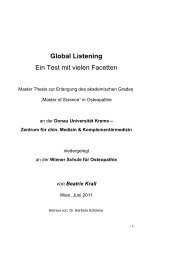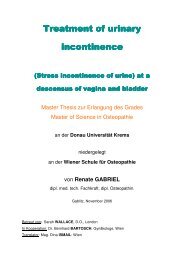Comparison between CV4 and EV4 - Osteopathic Research
Comparison between CV4 and EV4 - Osteopathic Research
Comparison between CV4 and EV4 - Osteopathic Research
You also want an ePaper? Increase the reach of your titles
YUMPU automatically turns print PDFs into web optimized ePapers that Google loves.
9<br />
fig. 1<br />
occipital bone<br />
2.1 Occipital bone<br />
The interface used to conduct the <strong>CV4</strong> <strong>and</strong> <strong>EV4</strong> cranial techniques is the<br />
occipital bone, the posterior base of the cranium. It consists of the basilar part,<br />
the squamous portion <strong>and</strong> the two condylar parts. The occipital bone is a part of<br />
the posterior cranial fossa, <strong>and</strong> together with the sphenoid, constitutes the SBS<br />
(sphenobasilar-symphysis). It is in contact through sutures laterally with the<br />
temporal bone, on top with the parietal bone <strong>and</strong> at the bottom with the condylar<br />
parts. The IX., X., XI. cranial nerves, the jugular vein, the inferior petrosus sinus<br />
<strong>and</strong> sigmoid sinus <strong>and</strong> the posterior meningeal artery all go through the jugular<br />
foramen, the opening located <strong>between</strong> the temporal bone <strong>and</strong> the occipital bone.<br />
A large part of the venal blood, approximately 80%, is drained via the jugular<br />
vein. Dural tensions or restrictions in the region of the jugular foramen can<br />
influence the function of the structures passing through it.<br />
Margit Grill / 2006
















